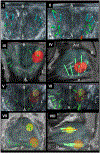Techniques and Outcomes of MRI-TRUS Fusion Prostate Biopsy
- PMID: 33748877
- PMCID: PMC9827754
- DOI: 10.1007/s11934-021-01037-x
Techniques and Outcomes of MRI-TRUS Fusion Prostate Biopsy
Abstract
Purpose of review: The goal of this study is to review recent findings and evaluate the utility of MRI transrectal ultrasound fusion biopsy (FBx) techniques and discuss future directions.
Recent findings: FBx detects significantly higher rates of clinically significant prostate cancer (csPCa) than ultrasound-guided systematic prostate biopsy (SBx), particularly in repeat biopsy settings. FBx has also been shown to detect significantly lower rates of clinically insignificant prostate cancer. In addition, a dedicated prostate MRI can assist in more accurately predicting the Gleason score and provide further information regarding the index cancer location, prostate volume, and clinical stage. The ability to accurately evaluate specific lesions is vital to both focal therapy and active surveillance, for treatment selection, planning, and adequate follow-up. FBx has been demonstrated in multiple high-quality studies to have improved performance in diagnosis of csPCa compared to SBx. The combination of FBx with novel technologies including radiomics, prostate-specific membrane antigen positron emission tomography (PSMA PET), and high-resolution micro-ultrasound may have the potential to further enhance this performance.
Keywords: Fusion biopsy; Image registration; Magnetic resonance imaging; Prostate cancer; Systematic biopsy; Ultrasonography.
Conflict of interest statement
Figures

References
-
- Ahmed HU, El-Shater Bosaily A, Brown LC, et al. Diagnostic accuracy of multi-parametric MRI and TRUS biopsy in prostate cancer (PROMIS): a paired validating confirmatory study. Lancet. 2017;389:815–22. 10.1016/S0140-6736(16)32401-1 - DOI - PubMed
-
This is a multicenter international paired validating study which evaluates biopsy-naïve men with mpMRI followed by TRUS-SBx and template mapping biopsy, determining that mpMRI is more sensitive and less specific than TRUS-SBx for detection of csPCa.
-
- Noguchi M, Stamey TA, McNeal JE, Yemoto CM. Relationship between systematic biopsies and histological features of 222 radical prostatectomy specimens: lack of prediction of tumor significance for men with nonpalpable prostate cancer. J Urol. 2001;166:104–10. 10.1016/S0022-5347(05)66086-7. - DOI - PubMed
Publication types
MeSH terms
Grants and funding
LinkOut - more resources
Full Text Sources
Other Literature Sources
Medical
Research Materials
Miscellaneous

